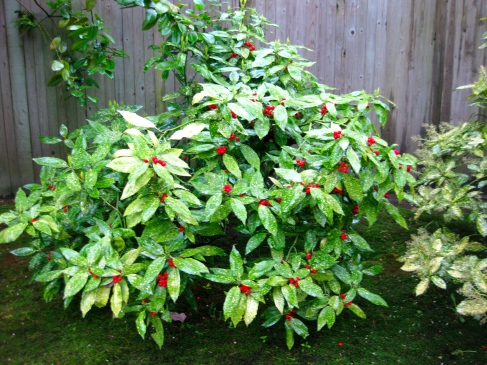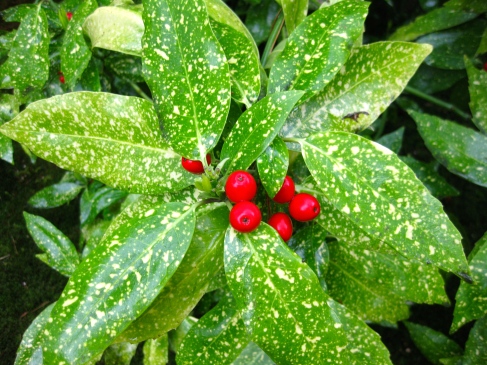Aucuba • Japanese Laurel • アオキ • 青木 • aoki
There are quite many of them in the SJG – all growing in semi-shady areas between the E path and the E fence, in areas D, G and I. We also have, along the same E side of the garden, the non-variegated version of aoki (in areas C and D), called just ‘aucuba japonica’.
When the Plant Committee first looked at them in 2011, some ‘variegated’ species lost their golden speckles, or serrated edges of the leaf, and then-senior-Gardener Kathy Blanchard explained it happens sometimes, depending on fertilizer, soil condition, sun exposure, etc… But they are all the same family of Japanese laurels, speckles or lack of them, serrated or not and caught in the picture below is a female plant with red fruit – Aucubas are NOT self-polinating, there has to be male and female plant nearby each other to produce fruit.
From a long article on ZipcodeZoo, illustrating the senior gardener point: […] Several species are difficult to distinguish from each other, as the characters used to separate them are variable. The margins of the leaves, used in the key , are not consistently reliable (or stable) features. […]
From Wikipedia: Aucuba japonica, commonly called spotted laurel, Japanese laurel, Japanese aucuba or gold dust plant (USA), is a shrub (1-5m) native to rich forest soils of moist valleys, thickets, by streams and near shaded moist rocks in China and Japan. This is the species of Aucuba commonly seen in gardens – often in variegated form. The leaves are opposite, broad lanceolate, 5–8 cm long and 2–5 cm wide. Aucuba japonica are dioecious, they have separate male and female plants. The flowers are small, 4–8 mm diameter, with four purplish-brown petals; they are produced in clusters of 10-30 in a loose cyme. The fruit is a red berry approximately 1 cm in diameter, which is avoided by birds.[…].
Aucuba japonica was introduced into England in 1783 by Philip Miller’s pupil John Graeffer, at first as a plant for a heated greenhouse. It became widely cultivated as the “gold plant” by 19th-century gardeners. The plants being grown were female, and it was a purpose of Robert Fortune’s botanizing trip to newly-opened Japan in 1861 to locate a male. It was located in the garden of Dr. Hall, resident at Yokohama, and sent to the nursery of Standish & Noble at Bagshot, Surrey. The firm’s mother plant was fertilized and displayed, covered with red berries, at Kensington in 1864, creating a sensation that climaxed in 1891 with the statement from the Royal Horticultural Society’s secretary, the Rev. W. Wilkes, “You can hardly have too much of it”. […]
From a long article ‘How to grow: Japanese laurel’ in The Telegraph: […] Their biggest blessing is an ability to survive for decades, although many gardeners have probably been put off by seeing lanky specimens in woodland. These ancient specimens can be rejuvenated. Many found in the once-overgrown gardens of English Heritage’s Brodsworth Hall, near Doncaster in Yorkshire, have been restored to tight evergreen roundels after 100 years of neglect. They were planted in the 1860s, when aucubas were fashionable. Now they jostle among clipped evergreens and ferns, turning that corner of Yorkshire into a Tuscan idyll. The garden glows in winter when the topiary looks crispest. […]
tagged



